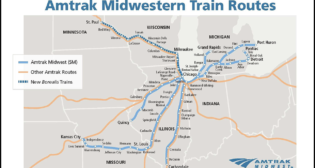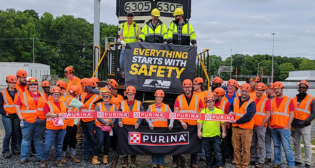
Study to test HSR components performance
Written by William C. Vantuono, Editor-in-ChiefThe University of Illinois at Urbana-Champaign has been awarded $3.3 million to study the performance of certain track components to improve safety and efficiency on rail routes served by freight rail and high speed (passenger) rail.
Many of the proposed and planned HSR or higher-speed rail (HrSR) lines in the U.S. would require passenger trains to share the same tracks as heavy-axle-load freight trains, the university says. The research to improve concrete crossties and fastening systems will be undertaken by the university’s Rail Transportation and Engineering Center (RailTEC), part of the Department of Civil and Environmental Engineering (CEE) at Illinois. It is sponsored by the Federal Railroad Administration which contributed approximately $2.4 million for the research. Industry partners will contribute the remaining $900,000.
“The magnitude of this project reflects the importance of improved concrete crosstie design for both freight and passenger railroads in the U.S,” said Christopher Barkan, RailTEC director and CEE professor.
“High speed passenger rail operations require the use of concrete crossties or slab track because these track systems allow railways to maintain the tight geometric tolerances, such as track gauge, necessary to accommodate their operation,” said CEE faculty member J. Riley Edwards, who is leading the study. “Many of the proposed and planned HSR lines in the U.S. will require high-speed passenger trains to share the same tracks with heavy-axle-load (HAL) freight trains.”
Edwards said the goal in part is to improve “concrete tie and fastener design in order to increase safety and reliability and lower their life cycle cost.”
During the two-and-a-half-year study, researchers will conduct laboratory and field testing to compile empirically gathered performance data. Improved understanding of the tie and fastening system is expected to facilitate the development of performance requirements and design recommendations for concrete ties and fastening systems in the U.S., specifically those used in joint passenger-freight railway infrastructure. They will also develop a centralized knowledge and document depository, to be housed at the University of Illinois, about concrete ties and fastening systems.
In addition to Edwards, the research team includes experts in materials and structures: CEE professors Bassem O. Andrawes, Daniel A. Kuchma, and David A. Lange, and Research Engineer Marcus S. Dersch, a CEE alumnus.
Industry partners involved in the project include: Amtrak; BNSF Railway; GIC Ingenieria y Construccion S.A. de C.V.; Hanson Professional Services Inc.; LB Foster Company, CXT Concrete Ties; Union Pacific Railway; and Unit Rail Inc./Amsted Rail Inc.



